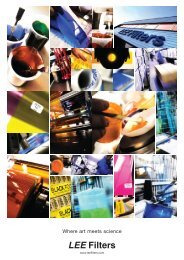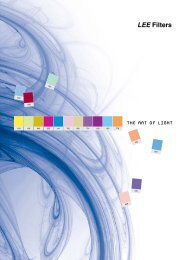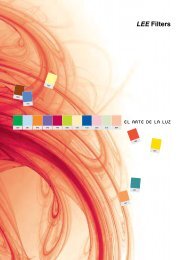INSPIRING PROFESSIONALS - LEE Filters
INSPIRING PROFESSIONALS - LEE Filters
INSPIRING PROFESSIONALS - LEE Filters
You also want an ePaper? Increase the reach of your titles
YUMPU automatically turns print PDFs into web optimized ePapers that Google loves.
<strong>INSPIRING</strong> <strong>PROFESSIONALS</strong><br />
THE LANDSCAPE PHOTOGRAPHER'S GUIDE TO USING FILTERS
Foreword<br />
My aim as a landscape photographer<br />
is simple, I want my photographs to<br />
express the sense of wonder<br />
the landscape inspires in me.<br />
Since light is the heart and soul of photography, the art of landscape<br />
photography is largely about the weather, and being in the right place at<br />
the right time. It is also learning the biological and geological richness of<br />
the planet, of seeing the beauty of rocks, plants and animals. It is seeing<br />
the space in the landscape, in sensing it’s freedom. It is coping with the<br />
heat of a summer day, the cold of a winter one. It is about walking,<br />
climbing, waiting; it involves anticipation, and reacting when the time is<br />
right. It is about tuning in to the place and the moment. It is watching the<br />
cycle of the seasons, and the circle of life. It is connecting with the earth.<br />
Yet in the end, it all comes back to light. The landscape photographer has<br />
no control over the light itself, for the sun is our light source, the sky is our<br />
studio, and the weather dictates mood and atmosphere. But we can<br />
control the light entering the camera. By combining precise timing<br />
(to make best use of the light as it unfolds) with the subtle use of filters we<br />
can ensure our compositions truly reveal the light and the land.<br />
Landscape photography is<br />
the art of light.<br />
Joe Cornish
Contents<br />
14 38 48 62<br />
Neutral Density<br />
Graduated <strong>Filters</strong><br />
Neutral Density<br />
Standard <strong>Filters</strong><br />
Warm Up<br />
<strong>Filters</strong><br />
Combination<br />
<strong>Filters</strong><br />
Mark Denton<br />
David Noton<br />
Mark Denton<br />
Joe Cornish<br />
Jeremy Walker<br />
Jeremy Walker<br />
John Gravett<br />
David Ward<br />
Joe Cornish<br />
Charlie Waite<br />
Tom Mackie<br />
John Gravett<br />
David Ward<br />
David Ward<br />
John Gravett<br />
Jeremy Walker<br />
4 • 5
78 94 104 110<br />
120<br />
Polariser<br />
Digital<br />
Glass Enhancer<br />
Effects<br />
Black & White<br />
<strong>Filters</strong><br />
John Gravett<br />
David Noton<br />
Jeremy Walker<br />
Tom Mackie<br />
Charlie Waite<br />
Joe Cornish<br />
John Gravett<br />
David Ward<br />
Jeremy Walker<br />
David Noton
Neutral Density Grad Hard<br />
Durdle Door, Dorset, England<br />
Jeremy Walker<br />
The huge rock arch of Durdle Door is situated<br />
on the South or Jurassic Coast and is a great place to visit<br />
especially in winter when you can have the place to yourself.<br />
0.6 ND<br />
Grad Hard<br />
81C<br />
Standard<br />
The Dorset coast is a great place to walk and<br />
has many bays and coves to explore but<br />
this has to be one of my favourite locations.<br />
This visit was on a cold grey winter's<br />
afternoon and I turned up more in hope<br />
than expectation, as a large blanket of<br />
cloud had been hiding the sun for most of<br />
the day. Having set the camera up and<br />
composed the shot, it was then a matter of<br />
waiting, and as the sun sunk lower and<br />
lower the cloud finally began to break and<br />
the light began to hit the arch.<br />
As is often the problem, the exposure<br />
difference between the sky and the<br />
foreground needs controlling. For this I used<br />
a 0.6ND hard grad placed just above the<br />
horizon. As the light was not as warm as I<br />
would have liked I used an 81C colour filter<br />
over the whole shot just to help the feel<br />
and mood of the shot.<br />
0.6 ND<br />
18 • 19
Neutral Density Grad Soft<br />
Chamber Of Secrets, Antelope Canyon, USA<br />
Joe Cornish<br />
I have made many photographic trips<br />
to the United States’Southwest deserts,<br />
sometimes leading workshops there.<br />
0.9 ND<br />
Grad Soft<br />
0.9 ND<br />
It was the wonders of this spectacular<br />
region that originally convinced me to<br />
become a landscape photographer.<br />
Antelope is a slot canyon, an extremely<br />
narrow opening in the earth's surface,<br />
sculpted over many centuries by the action<br />
of flash flooding.<br />
I used an Ebony 5x4 inch field camera, and<br />
a 90mm lens. The perspective is made<br />
looking up the wall of the canyon from a<br />
very low angle. My goal was to combine<br />
the swirling shapes of the canyon walls in a<br />
relatively abstract composition to express<br />
energy and movement in the solid rock.<br />
Spot-metering across the scene I discovered<br />
a brightness range in excess of eight stops.<br />
While I was prepared to lose the darkest<br />
shadows to black, it was essential that I<br />
hold the highlights in the upper canyon<br />
wall, and retain detail in the shadows of the<br />
overhang, for without them, the ebb and<br />
flow of the composition would be lost.<br />
I selected a three stop 0.9 ND soft grad to<br />
ensure there was no risk of a visible<br />
'tideline', and introduced it on its side from<br />
the left. It was inevitable that some detail<br />
would be sacrificed in the dark areas now<br />
covered by the ND, but the benefits of<br />
subduing the highlights were immediately<br />
apparent in camera. Placing the shadow<br />
on the right of the image at minus one and<br />
a half, compared to base exposure, I<br />
calculated that the highlights on the upper<br />
canyon would hold at plus two or so, taking<br />
the reduction of the ND into account.<br />
32 • 33
Neutral Density Standard<br />
House on Stilt. Great Ocean Road, Australia<br />
Charlie Waite<br />
Being privileged to have had three consecutive<br />
exhibitions in Australia, there was a little free time to<br />
drive along the famous Great Ocean Road.<br />
42 • 43<br />
0.9 ND<br />
Standard<br />
0.6 ND<br />
Standard<br />
Just a few miles out of Melbourne, I looked<br />
up to see a tall thick steel pole. On closer<br />
examination, I saw sitting right at the very<br />
tip of the pole a small hexagonal house;<br />
I felt compelled to go and investigate; after<br />
all 'investigation' is the business of the<br />
landscape photographer. A small steep<br />
track took me to the 'drawbridge' leading<br />
to the front door.<br />
I have always felt confined by the<br />
mandatory configuration of shutter speed<br />
and aperture, designed to ensure correct<br />
exposure. I have long used the 'uniform<br />
Neutral Density' filters in various densities to<br />
allow me to break out of the mandatory<br />
combinations of shutter speeds and<br />
apertures, which light intensity and film<br />
speed force me in turn to comply with.<br />
The ND uniform allows me a third exposure<br />
variable, which in turn gives enhanced<br />
freedom to express my intention.<br />
The surf in the background seemed to be<br />
intrusive and, unless softened could possibly<br />
deflect the eye away from the peculiar<br />
and surreal house. Using a combination of<br />
both a 0.9 and a 0.6 (five stops density)<br />
uniform Neutral Density filters, meant I could<br />
both maintain the sacred aperture and<br />
adopt a longer shutter speed which<br />
resulted in a more nondescript background.<br />
It is pleasing to know that despite the<br />
apparent appearance of computer<br />
manipulation in the making of this image;<br />
none took place. There was great pleasure<br />
to be had from 'in camera manipulation'<br />
using nothing so sophisticated as post<br />
production digital manipulation software<br />
(very difficult to replicate the effect of long<br />
shutter speeds); simply two humble Neutral<br />
Density filters placed in their holder in front<br />
of the lens; job done.
Warm Up <strong>Filters</strong><br />
The Roaches, Peak District, England<br />
Tom Mackie<br />
There are many times when using a combination of an ND grad<br />
and a graduated coral filter can make the difference between<br />
a stunning image, a transparency going<br />
in the bin or a deleted digital file.<br />
0.9 ND<br />
Grad Hard<br />
Coral 4<br />
Grad Hard<br />
0.9 ND<br />
Coral 4<br />
Even though digital has a wider exposure<br />
range, you still have to grad the skies down to<br />
hold the highlight detail. Many photographers<br />
new to digital photography think they can<br />
throw their filters away, choosing to make<br />
the alterations to the image using<br />
Photoshop. I prefer to capture a scene as<br />
close to the final image as possible, this<br />
saves countless hours of retouching on the<br />
computer later.<br />
I was commissioned to photograph the<br />
Peak District for a book publisher. One of<br />
the required locations was an area in the<br />
southwest part of the Peaks called the<br />
Roaches. This rock escarpment is very<br />
popular with rock climbers and an early rise<br />
was necessary to capture the warm tones<br />
on the rocks. I chose a suitable angle so<br />
that the first light would hit the ridge of<br />
granite rock formations. Unfortunately,<br />
there was a thin veil of cloud at the horizon,<br />
that would take out the intensity and<br />
warmth of the sun when it edged over the<br />
horizon. On the plus side, a nice cloud<br />
formation drifted into the scene to make<br />
the morning sky more interesting. A straight<br />
shot of the scene rendered the sky blown<br />
out and the little light that illuminated the<br />
rocks in the foreground was not as intense<br />
with colour as I'd have liked. Placing a<br />
0.9 ND hard grad over the sky was enough<br />
to balance the exposure of the sky with the<br />
foreground. I used a Coral 4 grad reversed in<br />
the holder to enhance the little amount of<br />
warm light on the rocks. Without the<br />
filtration the image is unusable, but with the<br />
addition of the ND grad and Coral grad the<br />
image achieves my intentions.<br />
54 • 55
Inspiration, advice and<br />
technique from leading UK<br />
landscape photographers<br />
<strong>INSPIRING</strong> <strong>PROFESSIONALS</strong><br />
technical@leefilters.com<br />
www.leefilters.com











